Persimmon Daikon Salad is quite popular in Japan as an autumn salad. The colours of orange and white are pretty and appetising, particularly with a small amount of green leaves added to it. The dressing is a simple mixture of oil, lemon juice and vinegar.
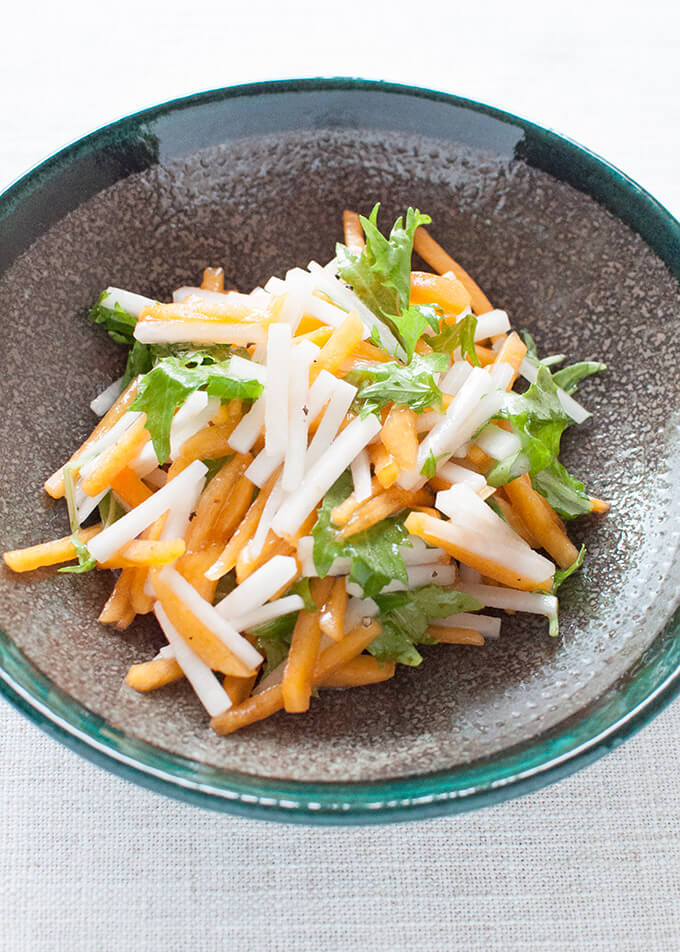
Autumn arrived in Sydney a bit later than usual but now it is getting quite chilly. There are many fruits and veggies that only appear in autumn and persimmon is one of them. Whenever I see persimmons at the shops, I really feel that autumn has arrived. And this is how people see persimmons in Japan.
About Persimmons
Persimmon is ‘kaki’ (柿) in Japanese. When ripe, persimmon is sweet and sometimes slightly tangy. The texture changes dramatically depending on the degree of maturity, starting with a firm crunchy texture and moving to very soft, almost like jelly.
Japanese people and persimmons have deep ties from ancient times. This is because the climate of Japan is perfectly suited to persimmons. Cross breeding has progressed and many varieties of persimmons were born. That’s the reason why the most commonly sold persimmons in Australia, and perhaps in some other countries, have Japanese names.
Among them, the most widely available persimmon is the Fuyu persimmon (Fuyū gaki, 富有柿) and Hachiya persimmon (Hachiya gaki, 蜂屋柿) – note that the word ‘kaki’ became ‘gaki’ following to the other word. The photo below shows Fuyu persimmon (top) and Hachiya persimmon (bottom).
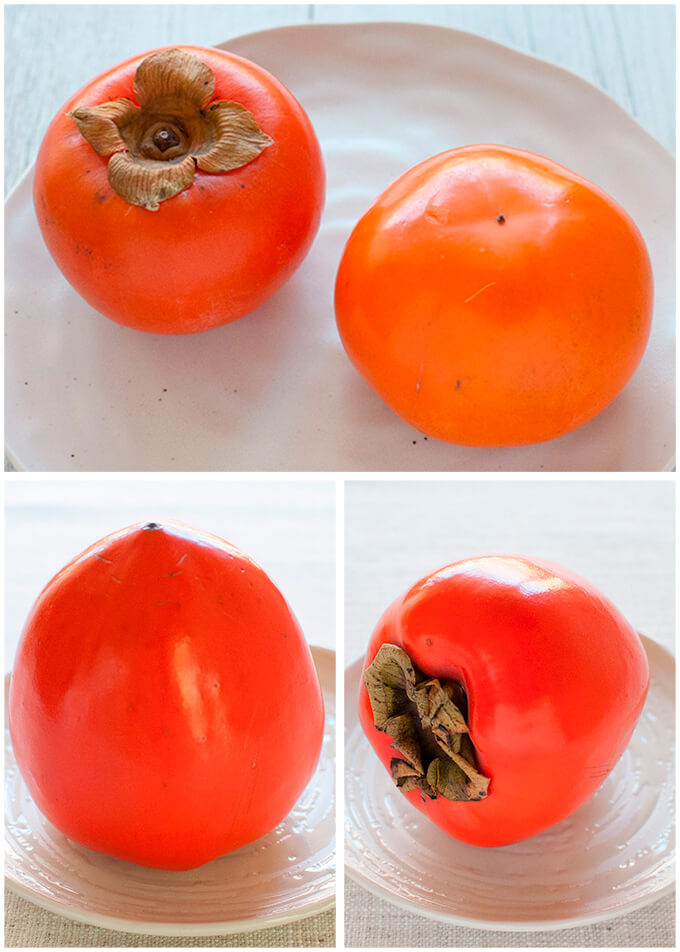
Fuyu persimmon has a tomato-like round shape. It is sweet and can be eaten even if it is crunchy and not fully ripe. On the other hand, Hachiya persimmon has an acorn-like shape and can be quite astringent while still immature. It should not be eaten until fully matured and ripened.
There is another persimmon species called Jiro persimmon (Jirō gaki, 次郎柿) that is often sold in Japan along with Fuyu persimmon. Jiro persimmon looks very similar to Fuyu persimmon, but it is flatter and squarish compared to Fuyu persimmon. The flesh of the Jiro persimmon is slightly harder than that of Fuyu persimmon. I have not seen Jiro persimmon sold in Sydney but in your country, you might get Jiro persimmon.
How to Eat Persimmon
In Japan, the most common way of consuming persimmons is simply as a fruit before it becomes too soft. Cut a persimmon into wedges, peel the skin and serve.
When a persimmon matures to the full extent, the flesh becomes jelly-like soft tissue. You can feel the soft flesh inside the skin by squeezing the persimmon. When the persimmon reaches this stage, I usually cut the top part of the skin off and scoop the flesh out with a spoon to eat it.
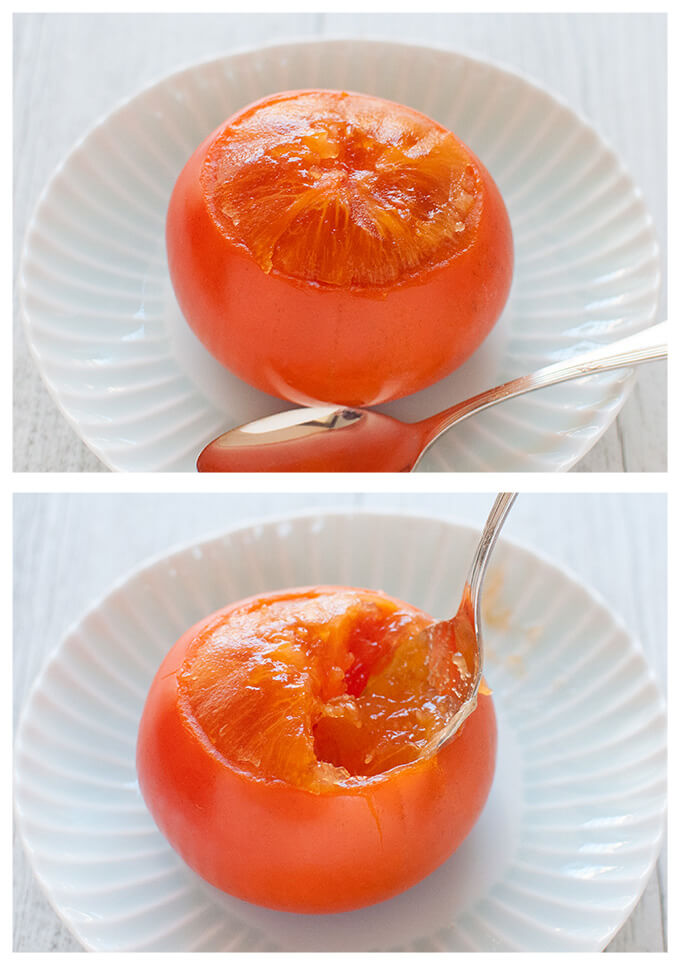
Another common way of eating persimmon is to dry unripe Hachiya persimmons until they become almost brown inside and eat them as dessert. Dried persimmons are very sweet even if the sweetness only comes from the persimmon itself. And the flesh inside becomes very sticky like a prune.
Dried persimmon is often covered with powder-like white substances. They are not fungus but sugar. Dried persimmon is called ‘hoshi gaki’ (干し柿) and you can see the images of hoshi gaki here.
Persimmon in Salad
But today’s persimmon recipe is a salad, which is also a common way of consuming persimmon. My Persimmon Daikon Salad uses a Fuyu persimmon as its flesh is firm yet has a sweet flavour. Simply cut both persimmon and daikon into matchsticks of similar lengths. Then dress with a simple salad dressing.
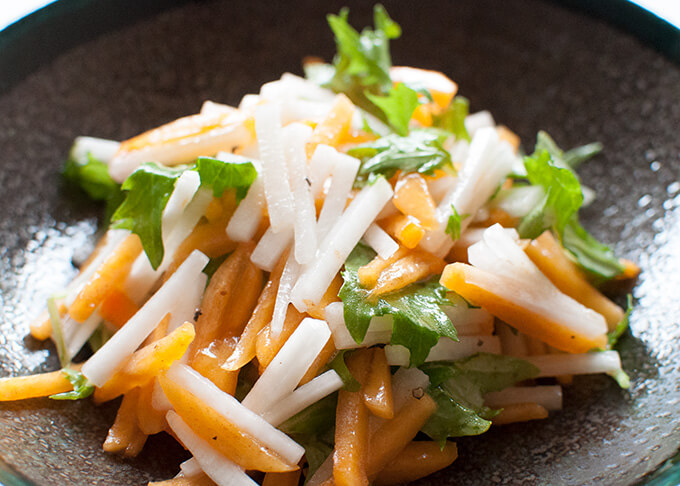
After removing the green top and peeling the skin, slice the persimmon vertically into 3mm (⅛”) thick slices, then cut each slice vertically again into 3mm (⅛”) thick matchsticks.
Daikon needs to be cut into a disc or two (depending on the size of daikon). Make sure the thickness of the disc is the same size as the length of the persimmon sticks. Slice the daikon disc vertically in exactly the same way as the persimmon to make matchsticks.
I added a little bit of mizuna leaf to give an extra colour to the salad, but this is optional. You can also use other green leaves like the photo below. I just sprinkled chopped fresh parsley.
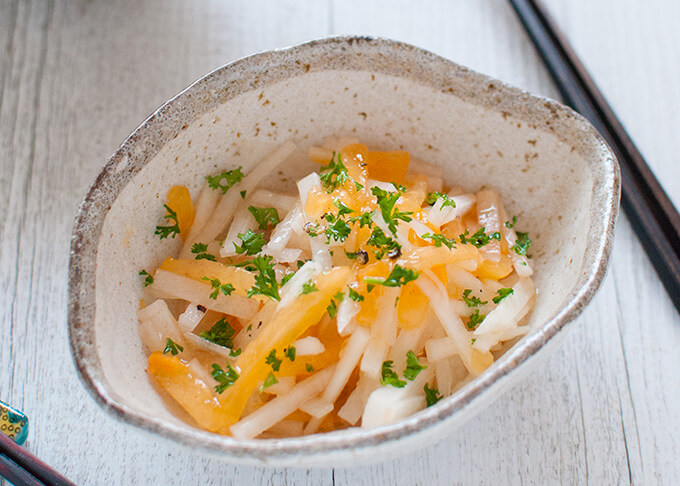
The dressing is a mixture of lemon juice, vinegar and oil. I used canola oil but any other plain oil such as peanut oil or grapeseed oil is fine. Because the flavour of persimmon is quite delicate, you don’t want to use strong-flavoured oil such as olive oil or sesame oil in the dressing as it will overpower the flavour.
Persimmon Daikon Salad is really the salad to enjoy the beautiful taste of autumn. I am aware that for the readers in the northern hemisphere it is nowhere near the persimmon season at the moment and I apologise for this. But your autumn is only 6 months away!
Yumiko![]()

Persimmon Daikon Salad is quite popular in Japan as an autumn salad. The colours of orange and white are pretty and appetising, particularly with a small amount of green leaves added to it. The dressing is a simple mixture of oil, lemon juice and vinegar.
- 150 g (5.3oz) daikon (about 2 discs of 4 cm (1½”) thick, note 2)
- 150 g (5.3oz) peeled persimmon (note 1)
- 15 g (0.5oz) mizuna leaves (optional, note 3)
- 1 tbsp lemon juice
- 1 tsp rice wine vinegar (or apple cider vinegar)
- 1 tbsp canola oil (or other plain oil, note 5)
- A pinch of salt
- Black pepper
-
Place a daikon disc on a cutting board, circle face down. Slice 3mm (⅛") thick, then cut the slices same direction into 3mm (⅛") matchsticks. Leave the daikon sticks in a bowl filled with chilled water (not in ingredients) for 5 minutes to make them crisp.
-
Slice persimmon vertically into 3mm (⅛") thick slices, then cut the slices the same direction into 3mm (⅛") matchsticks.
-
If mizuna leaves are large in relation to persimmon and daikon, cut them into two.
-
Place persimmon, daikon and mizuna in a bowl.
-
Put all the Dressing ingredients in a jar or a small bowl and shake/mix well.
-
Pour the dressing into the persimmon bowl and gently mix the salad so that persimmon, daikon and mizuna leaves are evenly scattered and well coated in the dressing.
-
Transfer salad to a serving bowl individually or a large bowl. Serve immediately.
1. My persimmon was not very large. After removing the green top and peeling the skin, it was about 150g (5.3oz). The weight does not have to be exact.
2. My persimmon matchsticks were about 4cm long. So, I made the daikon matchsticks the same length as the persimmon sticks to make the salad look neat and uniform. This is not mandatory but you may try to make them as close as possible.
I needed two discs because my daikon was not very large. You may only need one fat disc or three skinny discs. The ratio of daikon to persimmon sticks can also be adjusted.
3. It’s quite alright not to add mizuna or any other green for that matter. But I think that a little green colour makes this salad more vibrant. Instead of mizuna you can use baby spinach leaves, baby rocket leaves, sliced cucumbers or you can just sprinkle chopped parsley.
4. Other suggested plain oil includes peanut oil and grapeseed oil. Because the flavour of persimmon is quite delicate, you don’t want to use a strong-flavoured oil such as olive oil or sesame oil.
Yumiko san gobusata shiteorimasu.
Finally, I am on holiday and have time to read your posts. This salad sound great and delicious and since “Kaki” and Dikon is in season now, I would love to try this salad in this school holiday 😀
Hi Shihoko-san. Thanks for reading through my posts! This salad is very refreshing and I like it. Please let me know what you think. Have a relaxed holiday.